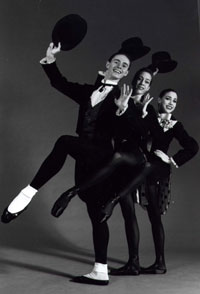
Choreography: Ruthanna Boris
Music: Louis Moreau Gottschalk, James Bland and
Anonymous Minstrels; complied by Paul Keuter and
Ruthanna Boris
A classical ballet is the form of a minstrel show, Cakewalk was premiered by New York City Ballet in 1951. At that time Lincoln Kirstein asked Ruthanna Boris to do a ballet in costume. Ms. Boris describes the ballet’s beginning: “In the warehouse I came across the costumes form Blackface, which had been a very serious ballet about black and white in the South in the antebellum period, and when I saw them, the idea of Cakewalk was born.”
“I did a lot of research on minstrels and discovered that around the period of Giselle (1842), minstrel shows were putting on caricatures of this kind of ballet. Hortense, Queen of The Swamp Lilies, is a kind of Giselle. And of course everybody was very busy with necrophilia in those days. Finally, I found a lady in her eighties who had been a cakewalk dancer and I took some lessons from her.”
Ms. Boris choreographed a series of dances which evokes a minstrel entertainment in the Mississippi showboat tradition. The choreography of the ballet draws its character from polyrhythmic African dance sources as equally as it draws its shape and content from European sources of balletic development. Each individual dance is choreographed to reveal one single element from the group of theatrical characteristics which have come to be associated with the performing style and repertoire of American minstrelsy, circa 1830-60. Although the ballet has been composed to show forth in the terms of American minstrelsy, it actually draws its entity and essence from a deeply balletic concept. Ms. Boris has colored the balletic movements with the inflections of folk dance and the rhythms and mannerisms of the minstrel show.
The dancing style, developed through the use of academic ballet technique, includes a strong infusion of the buoyant drive and foursquare energy which are the basic qualities of traditional Cakewalk rhythms, kicks, struts and style. The traditional cakewalk was invented and developed by black people during their bondage in American slavery.
The choreographic structure of the work consists of appropriate combinations of steps, movements, and floor patterns which have all been coordinated within timing, phrasing, and accenting according to the specific quality requirements of each individual dance.
There is no story to Cakewalk; the ballet is instead a series of dances. The Interlocutor supervises all, and the Ends keep discipline on the distant flanks. These three also have opportunities to dance as well as to introduce the other dances.
World Premiere: June 13, 1951, New York City Ballet, New York
Kansas City Ballet Premiere: February 25, 1988